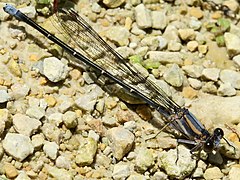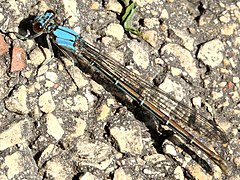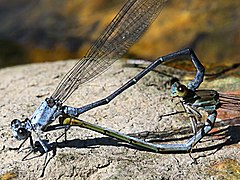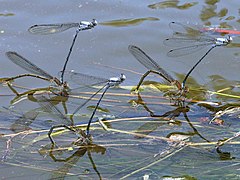| Powdered dancer | |
|---|---|

| |
|
Scientific classification
| |
| Domain: | Eukaryota |
| Kingdom: | Animalia |
| Phylum: | Arthropoda |
| Class: | Insecta |
| Order: | Odonata |
| Suborder: | Zygoptera |
| Family: | Coenagrionidae |
| Genus: | Argia |
| Species: | A. moesta
|
| Binomial name | |
| Argia moesta | |

| |
| Range of A. moesta [4] | |
The powdered dancer (Argia moesta) is a damselfly of the family Coenagrionidae. It is native to North America. It may be seen year-round in at least some of its range. [5]
Etymology
The common name refers directly to the male's pruinosity, appearing to be covered with a powdery blue or grayish substance. Older males are more pruinose, and may even be more ash white than blue. The specific epithet moesta, means sorrowful, [6]: 12 and may refer to customs (such as those on Ash Wednesday) of dusting oneself with ashes to express sorrow or mourning.
Description

Males have a blue tip at the end of the abdomen. Immature (freshly moulted, or teneral) males are tan to dark brown, turning darker with age and becoming almost completely whitish ( pruinose) at maturity. [7]: 62–63 Females come in blue and brown forms based on the color of the thorax, which has hair thin dark shoulder stripes. [8] The blue form female is very similar to the female blue-fronted dancer; a key to separating these two is the number of cells below the stigma: our species has two cells below the stigma where a blue-fronted dancer has one. [9]
-
teneral male
-
mature male
-
brown form female
-
blue form female
Breeding
During mating, a male uses claspers at the end of his abdomen to grab a female between the head and thorax, forming a tandem. The female then bends her abdomen to engage segments 2–3 of the male, where sperm is stored, forming a heart-shaped "mating wheel". Both sexes can change color during mating. [7]: 5–6 [10] The pair often remains attached until eggs are laid by the female. The female finds a shallow aquatic plant and uses her ovipositor to insert her eggs in dead or live tissue while guarded by her mate. [11]
-
pair in tandem
-
mating wheel
-
ovipositing
References
- ^ Paulson, D.R. (2017). "Argia moesta". IUCN Red List of Threatened Species. 2017: e.T165038A65827364. doi: 10.2305/IUCN.UK.2017-3.RLTS.T165038A65827364.en. Retrieved 6 June 2023.
- ^ NatureServe (2 June 2023). "Argia moesta". NatureServe Network Biodiversity Location Data accessed through NatureServe Explorer. Arlington, Virginia: NatureServe. Retrieved 6 June 2023.
- ^ "Argia moesta". Integrated Taxonomic Information System.
- ^ "Distribution Viewer". OdonataCentral. Retrieved December 5, 2009.
- ^ Abbott, John C. (2005). Dragonflies and Damselflies of Texas and the South-Central United States. Princeton University Press. pp. 77–78. ISBN 0-691-11364-5.
- ^ Paulson, Dennis R.; Dunkle, Sidney W. (12 February 2021) [Originally published June 1999]. "A Checklist of North American Odonata" (PDF). Jim Johnson. Retrieved 6 June 2023 – via Odonata Central.
- ^ a b Dubois, Bob (2005). Damselflies of the North Woods. Kollath-Stensaas Publishing. ISBN 0967379377.
- ^ "powdered dancer (Argia moesta)". MinnesotaSeasons.
- ^ "Argia moesta Powdered Dancer". Wisconsin Odonata Survey. Wisconsin Department of Natural Resources.
- ^ Suhling, Frank; Sahlén, Göran; et al. (2015). "Chapter 35 - Order Odonata". In Thorp, James H.; Rogers, D. Christopher (eds.). Thorp and Covich's Freshwater Invertebrates (Fourth ed.). Elsevier. pp. 893–932. doi: 10.1016/C2010-0-65590-8. ISBN 978-0-12-385026-3.
- ^ Paulson, Dennis (2011). Dragonflies and Damselflies of the East. Princeton University Press. pp. 151–153. ISBN 978-1-4008-3966-7.
External links
- Argia moesta on BugGuide.Net
- IUCN Red List least concern species
- NatureServe secure species
- Coenagrionidae
- Odonata of North America
- Insects of the United States
- Insects of Canada
- Insects of Mexico
- Fauna of the Eastern United States
- Fauna of the Western United States
- Fauna of California
- Insects described in 1861
- Coenagrionidae stubs








